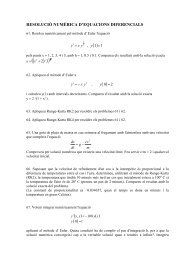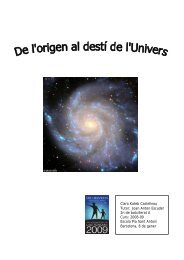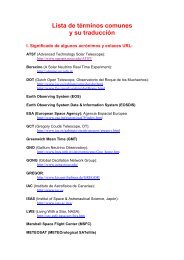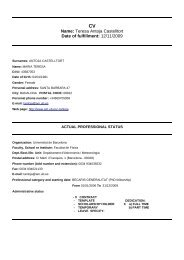Universitat de - Departament d'Astronomia i Meteorologia ...
Universitat de - Departament d'Astronomia i Meteorologia ...
Universitat de - Departament d'Astronomia i Meteorologia ...
Create successful ePaper yourself
Turn your PDF publications into a flip-book with our unique Google optimized e-Paper software.
Chapter 4<br />
The cross-i<strong>de</strong>ntification method<br />
4.1 Introduction<br />
As discussed in Sect. 1.3, the reduced population of known microquasars gave us a<br />
strong motivation to start a long-term project focused on the search for new micro-<br />
quasars in the Galaxy. In this context, X-ray, optical and radio catalogs provi<strong>de</strong> a<br />
fundamental tool for the search of new sources with known multiwavelength behav-<br />
ior. Therefore, we have used the best available X-ray and radio catalogs to search<br />
for new REXB candidates on the basis of positional coinci<strong>de</strong>nce, together with very<br />
restrictive selection criteria. As a result we have obtained a sample of 13 radio<br />
emitting X-ray sources, which is expected to contain some galactic X-ray binaries.<br />
4.2 Cross-i<strong>de</strong>ntification between RBSC and NVSS<br />
catalogs<br />
In or<strong>de</strong>r to find new microquasar candidates we have to search for new REXBs. The<br />
first step, hence, has consisted of a positional cross-i<strong>de</strong>ntification 1 of X-ray and radio<br />
sources using the most complete available catalogs at both wavelengths, namely the<br />
ROSAT all sky Bright Source Catalog (RBSC) and the NRAO VLA Sky Survey<br />
(NVSS), which are briefly introduced now.<br />
1 Published in Pare<strong>de</strong>s, J. M., Ribó, M., & Martí, J. 2002, A&A, 394, 193.<br />
121






